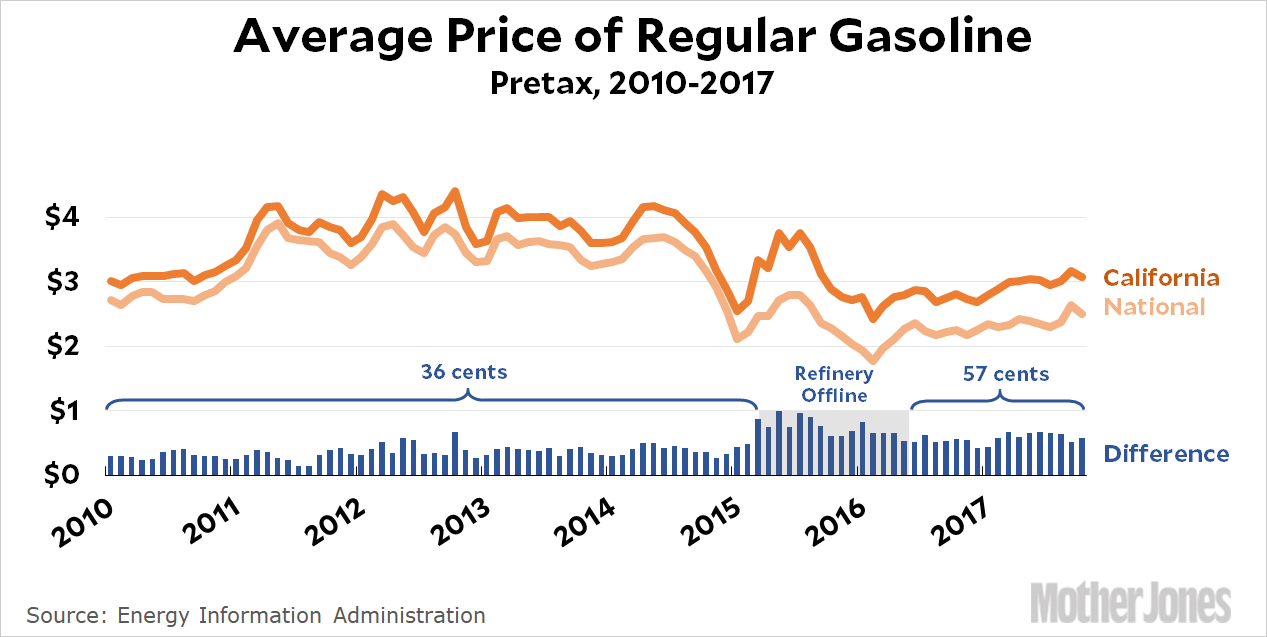This chart illustrates a mystery:

Because of special formulation requirements, California gasoline is always more expensive than gasoline in the rest of the country. As you can see, from 2010 through 2015 it averaged about 36 cents more per gallon.
In February 2016, an explosion at a refinery in Torrance took 10 percent of California’s capacity offline. As you’d expect, prices spiked: the California premium went up to about 76 cents above the national average.
But when the Torrance refinery came back online, a funny thing happened: prices came down, but not to their previous level. For some reason, California gasoline now costs about 57 cents more than the national average. Here is Michael Hiltzik in the LA Times:
Estimates of the size of the mysterious premium in prices per gallon being collected by the state’s refineries range from at least 20 cents per gallon — as calculated by UC Berkeley energy economist Severin Borenstein — to more than 30 cents, as reckoned by the advocacy group Consumer Watchdog.
….Soon after the Torrance explosion, the California Energy Commission asked its Petroleum Market Advisory Committee to analyze the event’s price impacts….The report mentioned an “unexplained differential” between prices in California and the national average that persisted even when the unique features of the state’s gasoline market were subtracted….Californians appeared to have paid an extra $12 billion at least since the 2015 Torrance explosion.
….The Petroleum Market Advisory Committee didn’t assert that there was anything illegal about the persistently high gas prices after the Torrance explosion. But it was convinced that the extra money was going to the refineries, because their margins — that is, the difference between their cost for crude oil and the wholesale price they charge for gasoline, had “remained elevated for an unexpectedly long time” after the explosion.
The refinery lobby claims the increased premium is just due to market forces, “as well as our state being a fuel ‘island,’ without pipelines bringing refined petroleum products into California.” Not everyone agrees:
Consumer Watchdog contends that another factor is a lack of refinery competition. Four companies — Chevron, Tesoro, Phillips 66 and Valero — control a combined 78% of statewide refining capacity; Chevron and Tesoro alone control more than half of all capacity. That may make it easier for refiners to tighten production at will, driving costs higher, as consumer advocates warned in 2013, when then-Atty. Gen. Kamala D. Harris approved the sale of BP’s Carson refinery to Tesoro. (Harris maintained that conditions she imposed on the sale would protect consumers from price pressures.)
And that’s where things stand. Refineries appear to have pocketed $12 billion in extra profits thanks to the Torrance refinery explosion. But the refinery lobby says there’s nothing to see here: it’s just capitalism at work. And nobody in the California government seems to care much about investigating further. As Hiltzik points out, this is odd considering the fuss being kicked up over California’s 12-cent increase in the gasoline tax, which will finance repairs to roads and bridges. If that’s such a big deal, why is it that nobody seems to care about a 20-30 cent price hike going straight into the refinery industry’s pocket?

















